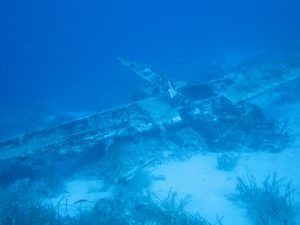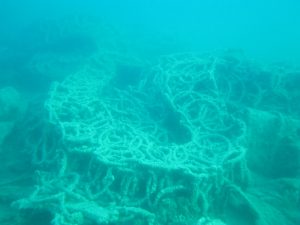It is well known and obvious for anyone looking at a map, that Kefalonia had a pivotal location and role on the marine traffic in antiquity, from early Greek to late Roman and Byzantine times. However, this same location of Kefalonia at the exit of Gulf of Corinth and in proximity with Patras created the setting of many less or well-known wartime tragedies during both World Wars, not only in land but also in the seas around the island. And whilst for stories like the Massacre of the Acqui Division there are books, documentaries and films, there are many maritime war tragedies yet to be told, and sea graves to be discovered. The material could already fill books and much more valuable information from surveys and archives fills gaps and expands our knowledge, and hopefully will find its way to the public soon. But for now, the focus will be on WWII wrecks that lay in depths accessible by divers.

WWII wrecks of Kefalonia
Two of them are closely related to the Massacre of the Acqui Division, also known as the Cephalonia Massacre. That was the mass execution of the men of the Italian 33rd Infantry Division Acqui by the Germans on the island of Kefalonia, Greece, in September 1943, following the Italian armistice with the Allies during WWII. More than 9000 Italian soldiers were killed in action, massacred or drowned when the commandeered ships taking the survivors to concentration camps were sunk. The story takes place in 1943.
Following the decision of the Italian government to negotiate a surrender to the Allies, the armistice went public on September 8, 1943 and there was a thin and fragile balance between peace and war on Kefalonia. The Acqui Division had been the Italian garrison of Kefalonia since May 1943 and consisted of 11,500 soldiers and 525 officersunder General Antonio Gadin. However German forces had a 2000 men strong presence on the island, mainly in Lixouri area under Lt Colonel Johannes Barge. In the days between 8-13 of September, Gadin had nothing but controversial orders and directions by his senior commander in Greece, General Vecchiarelli and the Italian government under General Badoglio on what to do, either surrendering to the German former allies or fighting back if attacked. To make things worse, on September 11, Colonel Barge handed Gandin an ultimatumto either fight alongside with the Germans, or hand over arms peacefully.
General Gadin was facing this dilemma until the early hours of September 13 when a German convoy including two landing crafts carrying vehicles, spare parts and fuel, attempted to enter the harbor of Lixouri. Italian artillery officers, on their own initiative, ordered the batteries on the hills around Argostoli to open fire, scoring direct hits on F494 “Tinos” and F495 “Naxos”, resulting the sinking of F495. F494 was apparently heavily damaged and almost sunk but salvaged and repaired.
In the incident five German soldiers were killed and General Gadin came under pressure to take a decision and presented his troops the options presented to him by Barge. Italian troops were in favour of resisting the German forces so on September 14, Gadin refused to surrender. As a result, in the morning of 15 September, the German Luftwaffe began bombarding the Italian positionsand the hostilities resulted in the Italian defeat. On September 22 the last Italians surrendered, and the events of the Massacre of Acqui Division followed.
So, hostilities of this chapter of WWII started with the sinking of F495 “Naxos” Landing Craft. Little was known about this until was discovered and identified by local divers in 2007. It is severely damaged and rests in shallow waters of 9-15 m. The seabed composition is sea grass and sand with wreck debris scattered over a huge area approximately 250 long and 40 m wide, with fuel barrels, jerry cans, few motorcycles, vehicle spare parts, antisubmarine nets, artillery parts, ammunition and other cargo.

F-495 Naxos
Whilst most of the surrendered Italians were executed, an estimated 2-3000 according to some sources, were to embarke in ships and taken in concentration camps. Some of them made it to their destinations and others drowned when the ships were sunk in various locations in the Adriatic, by the Allies. But the tragedy of the prisoners onboard SS Ardena was to take place before the eyes of the locals.

SS Ardena (HMS Peony)
Originally built for British Royal Navy in 1915 as HMS Peony, the vessel was a sloop minesweeper of Azalea-class. After WW I was acquired by London & South West Railway and later by Southern Railway, renamed SS Ardena and used on the routes of Southampton and Cherbourg/Caen until sold to on 1934 to Toyias Shipping Company in Piraeus, Greece.
During the days of German invasion in Greece, on April 6, 1941, was sunk by Luftwaffe in Piraeus but later raised and used by the German Navy. The final act came on September 28, 1943, when SS Ardena was sailing from the island of Kefalonia to the mainland Greece with some 840 Italian prisoners. At the exit of the bay of Argostoli probably hit an unmarked sea-mine of the minefield Italians have laid earlier and sank with great loss of life.
The vessel was in the middle of the shipping lanes and in water shallow enough for the masts to reaching the surface. Although being a war grave, in the grim years after the war, the top deck parts and superstructure were salvaged and what remains today is the bottom part of the keel, still keeping its ship line, along with scattered debris around at the seafloor, and at a depth of 29 m. The visibility on the site is often limited by currents stirring the sediment. However, divers visiting the site with the outmost respect, can see personal items such as boots, shaving razors, tin plates and flasks and sometimes even human remains. Every year on the day of the sinking, a ceremony is held by Italian and Greek officials. On 2009, Italian Navy divers laid on the site a commemorative plaque to the memory of the souls lost.

Divers bringing the commemorative plaque at SS Ardena
Roughly at the same time another boat was lost to enemy action just off the coast of Poros. On May 23, 1943, Captain Miltiadis Houmas, agent of the Greek branch of MI9, arrived in Poros, Kefalonia, with orders by Major Michael W.Parish to help John Capes, the sole survivor of HMS Perseus to escape, after spending 18 months in Axis occupied Kefalonia, hidden by the heroic locals. The above information as well as the following abstract is by Kostas Thoctarides book, who discovered the submarine wreck in 1997:
“At 13:30 in the afternoon, five English planes and one American, flying low, almost at sea level, made their appearance. A caique had left Zakynthos. Strafed from above, the caique caught fire. The Italians immediately came on board our caique and asked us to head for the wreck in order to collect the shipwreck survivor”.

150mm shells at the WWII wreck
As indicated by the recent research, this same caique wreck lies off shore Kapros Cape in Skala at a depth of 40 m. Divers approaching the wreck encounter a pile of war supplies in the shape of a vessel that its wooden parts have long rotted away, in a dive into history for WWII enthusiasts. A worth-reading extensive article with all recent findings and historical research can be found here:
https://www.bluemantadiving.gr/the-extraordinary-wwii-shipwreck-of-cape-kapros-in-kefalonia/
As Kefalonia was occupied by Axis forces during WWII providing harbour for their ships, there is no surprise that there were many Allied air raids around the island. Many Allied airplanes have shot and crashed around Kefalonia, some laying in extremely deep waters and some awaiting to be discovered. One of them is rumored to lay in the bottom of Argostoli bay but has not been found yet.
On the north of the island, near Fiskardo, there is a known airplane crash site. A SAAF Bristol Beaufighter raiding Fiskardo harbour was shot by German anti-aircraft defences and crashed at Kimilia bay, having its navigator killed and the pilot surviving to be captured. After the war the plane was towed closer to the shore and salvaged due to its precious metals and nowadays few pieces remain scattered on the seabed and can be seen by divers, along with a commemorative plaque, at a depth of 8-10m.

A Bristol Beaufighter
Very little, if at all, is known for the wreckage of a Luftwaffe Ju 88 at the southeastern tip of Ithaca on the crest of a sloping reef that shortly reaches the contour line of 100 meters.

Ju 88 tail part
The aircraft met its fate as it ditched a short distance offshore reportedly hit by allied fire. It is shocking to imagine the force of the crash as the two engines can be found far apart at 22 and 28 meters of depth and the tail sits at 36m much further away. Probably parts of fuselage have rolled deep down the slope, off limits for recreational divers but pieces of the wings are found and positively identified around the top of the reef.

Luftwaffe Ju88 engine
Beyond any doubt, the most known WWII wreck in Kefalonia and probably among the most known in the world is the British Overseas Patrol submarine HMS/M Perseus, (N36) that lies virtually intact on the sandy bottom, at 52 meters depth, about a mile off the south coast of Kefalonia. HMS Perseus was a Parthian class submarine built by Vickers-Armstrongs at Barrow in Furness in 1929.

HMS Perseus (N36)
Perseus submarine is perhaps the the top WW II wreck dive in Mediterraneanand probably the best submarine dive in the world but beyond being among the most impressive wreck dives a diver can experience, also has an amazing history as well. The vessel was on combat patrol in December 1941, and while cruising at the surface at night hit an Italian naval mine and sunk. From the crew of 59 only one, the Royal Navy leading stoker John Capes managed a daredevil escape from a depth no one has attempted before. In fact, during the whole of the war there were only four escapes from stricken British submarines. Capes swam his way to Katelios and with the aid of locals escaped capture from Italian and German occupation forces and finally transferred in Turkey. While legendary in Royal Navy, almost nobody believed his adventure until in 1997 the team of Greek diver and u/w explorer Kostas Thoctarides located the submarine and verified details of his described escape.
The divers approaching the submarine encounter a magnificent vessel 88 meters long, with a large conning tower, the ship’s gun and the rear hutch still open indicating the escape route of John Capes, while a look in the interior is possible. Among other things, the torpedo tubes and the ship’s propellers and rudder are visible, as well as the damage caused by the sea mine. The anchor of the mine still can be seen few meters from the aft of the submarine. Much is said about this magnificent wreck and its tragic story and more details on the story of John Capes can be found here:
https://www.bbc.com/news/magazine-15959067
These wrecks are just the few that lay in depths that can be accessed by divers and can fill many WWII history pages. But as monuments of wartime tragedies and war graves, should be treated with outmost respect. Just like the many more around Kefalonia, from both World Wars that lay in deep waters or still waiting to be discovered.
This article couldn’t be written without the research of
Kostas Thoctarides, Tilemanchos Beriatos and Steve Worthington



























